
Odonata is an order of flying insects that includes the dragonflies and damselflies. Like most other flying insects, they evolved in the early Mesozoic era. Their prototypes, the giant dragonflies of the Carboniferous, 325 MYA, are no longer placed in the Odonata but included in the Protodonata or Meganisoptera.
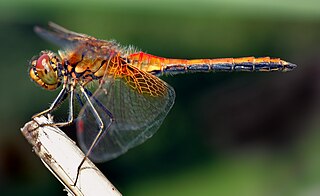
A dragonfly is a flying insect belonging to the order Odonata, infraorder Anisoptera. About 3,000 extant species of true dragonfly are known. Most are tropical, with fewer species in temperate regions. Loss of wetland habitat threatens dragonfly populations around the world. Adult dragonflies are characterized by a pair of large, multifaceted compound eyes, two pairs of strong, transparent wings, sometimes with coloured patches, and an elongated body. Many dragonflies have brilliant iridescent or metallic colours produced by structural colouration, making them conspicuous in flight. An adult dragonfly's compound eyes have nearly 24,000 ommatidia each.

Damselflies are flying insects of the suborder Zygoptera in the order Odonata. They are similar to dragonflies, which constitute the other odonatan suborder, Anisoptera, but are smaller and have slimmer bodies. Most species fold the wings along the body when at rest, unlike dragonflies which hold the wings flat and away from the body. An ancient group, damselflies have existed since at least the Lower Permian, and are found on every continent except Antarctica.
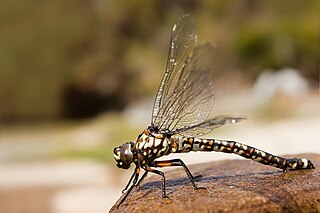
The Aeshnidae, also called aeshnids, hawkers, or darners, is a family of dragonflies. The family includes the largest dragonflies found in North America and Europe and among the largest dragonflies on the planet.

The flame skimmer or firecracker skimmer is a common dragonfly of the family Libellulidae, native to western North America.

Pantala flavescens, the globe skimmer, globe wanderer or wandering glider, is a wide-ranging dragonfly of the family Libellulidae. This species and Pantala hymenaea, the "spot-winged glider", are the only members of the genus Pantala. It was first described by Johan Christian Fabricius in 1798. It is considered to be the most widespread dragonfly on the planet with good population on every continent except Antarctica although rare in Europe. Globe skimmers make an annual multigenerational journey of some 18,000 km ; to complete the migration, individual globe skimmers fly more than 6,000 km —one of the farthest known migrations of all insect species.

The Gomphidae are a family of dragonflies commonly referred to as clubtails or club-tailed dragonflies. The family contains about 90 genera and 900 species found across North and South America, Europe, Asia, and Australia. The name refers to the club-like widening of the end of the abdomen. However, this club is usually less pronounced in females and is entirely absent in some species.

The blue dasher is a dragonfly of the skimmer family. It is the only species in the genus Pachydiplax. It is very common and widely distributed through North America and into the Bahamas.

The Pseudostigmatidae are a family of tropical damselflies, known as helicopter damselflies, giant damselflies, or forest giants. The family includes the largest of all damselfly species. They specialize in preying on web-building spiders, and breed in phytotelmata, the small bodies of water held by plants such as bromeliads.

Megaloprepus caerulatus is a damselfly of the Forest Giant family (Pseudostigmatidae), found in wet and moist forests in Central and South America. It has the greatest wingspan of any living damselfly or dragonfly, up to 19 centimeters (7.5 inches) in the largest males. Its large size and the markings on its wings make it a conspicuous species; a hovering Megaloprepus has been described as a "pulsating blue-and-white beacon".

Somatochlora sahlbergi, the treeline emerald, is a species of dragonfly in the family Corduliidae. It is found at high latitudes across northern Eurasia and North America, and occurs farther north than any other dragonfly.
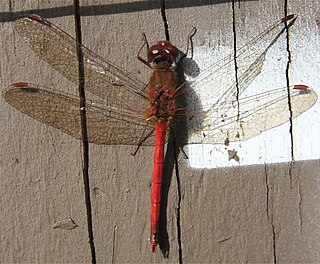
Sympetrum vicinum, the yellow-legged meadowhawk or autumn meadowhawk, is a member of the Libellulidae family and grows to 26–35 mm long.

Libelluloidea is a superfamily of dragonflies.

The Japanese relict dragonfly, is one of the four species of the genus Epiophlebia, belonging to the family Epiophblebiidae, which is itself the sole living representative of the Epiproctan infraorder Epiophlebioptera.
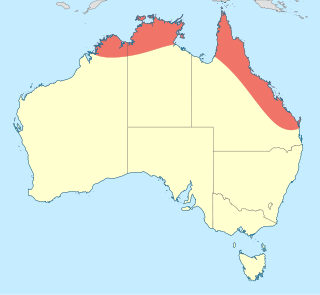
Macromia tillyardi is a species of dragonfly in the family Macromiidae, known as the Australian cruiser. It is a large, black to metallic green dragonfly with bright yellow markings on its abdomen, clear wings and long legs. It is found in northern Australia, where it inhabits streams and pools.
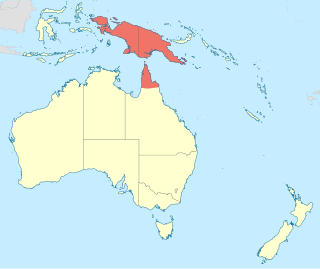
Macromia viridescens is a species of dragonfly in the family Macromiidae, known as the rainforest cruiser. It is a large, black to metallic green dragonfly with yellow markings on its thorax, dark metallic green on its abdomen, clear wings and long legs. It is found on Cape York in northern Queensland, Australia, and New Guinea, where it inhabits streams.
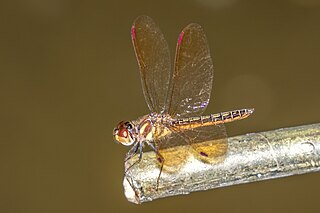
Perithemis domitia, the slough amberwing, is a species of skimmer in the dragonfly family Libellulidae. It is found in the Caribbean Sea, Central America, North America, and South America.
Hemicordulia hilaris is a species of Pacific dragonfly in the family Corduliidae, first described by the Dutch entomologist Maurits Lieftinck in 1975. The species is found across the Pacific Islands including Samoa and New Caledonia, with its range extending east to the Cook Islands and French Polynesia.
2. Young, Frank N.; Westfall, Minter J. (1955). "Review of A Manual of the Dragonflies of North America (Anisoptera). (Including the Greater Antilles and the Provinces of the Mexican Border.), Minter J. Westfall, Jr". Quarterly Journal of the Florida Academy of Sciences. 18 (2): 125–127. ISSN 0015-3850.
















